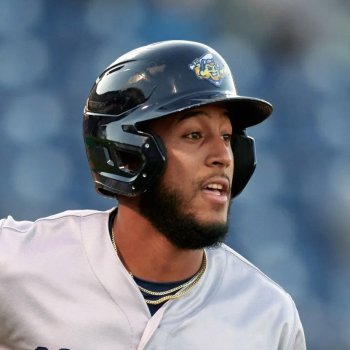
Twins Video
You probably can’t help but notice that Gonzalez seemingly came out of nowhere, grabbed attention during the Astros’ 2017 World Series run with a career year at age 28, and then turned in a down year in 2018 on the cusp of free agency. That’s one potential reason he was available in late February.
After digging in, it appears that Gonzalez’s 2017 breakout season was really a combination of things including optimization of his swing, refining his zone approach and, perhaps, punctuated with a bit of luck.
Let’s start with the swing.
While he is a switch-hitter, because over 70% of his career plate appearances happened in the left-handed batter's box -- and will likely be where he receives the bulk of his at-bats going forward -- we will focus on this. Over the first 5 seasons of his career, he posted a pedestrian .256/.296/.382 from the left-side. In the last two -- which was mostly driven by his 2017 performance (we’ll get into that later) -- Gonzalez has hit .280/.362/.477.
Look back at his home run totals from the left-side:
2012 - 2
2013 - 4
2014 - 6
2015 - 6
2016 - 8
2017 - 18
2018 - 11
So what happened where he finally achieved his breakout in an age-28 season? To understand his power progression, you have to understand how his swing has grown.
Below is a comparison of two of Gonzalez’s left-handed swings. The one on the left is from 2015 -- you know, The Weeknd, Adele, Inside Out, Mad Max Fury Road, Obama, etc. Classic 2015. The one on the right is from 2017 -- Cardi B, Imagine Dragons, Get Out, Blade Runner 2049, Trump, etc. Standard 2017 stuff.
Like those two years, Marwin Gonzalez’s swing is essentially the same but also radically different. While the components are similar, such as the big leg-kick and low hands, there are some subtle yet very important changes to his movement patterns.
From a high-level perspective, it is a more connected swing.
What do I mean by more connected? It simply means that the kinetic chain sequence is working as a unit rather than independent parts of the body.
For example, look at the hand load portion of his swing. From the 2015 clip, you see his hands pick up the bat and bring it to the launch point. His back elbow is picking up the bat. It is drifting. In 2017, his hands, elbow, and bat remain in the same spot as he steps away, leaving the barrel ready to fire at the launch point.
Another way to explain what is happening is by using your index finger and thumb, curl your finger back toward your thumb — without touching the two fingers — and flick forward. Now do the same thing but put your index finger on your thumb, feel that tension for a second and then flick. Much more potent, right? That’s the difference between these two movements.
This was something that Eduardo Escobar changed during his career with the Twins which helped provide more power but also gave him more time to identify pitches. By staying taut and stretching rather than moving to a spot, it gives the hitter extra fractions of milliseconds to identify a pitch. A rolling start, like his 2015 swing, can also be more difficult to shut a swing down. For Gonzalez, the change helped him ID breaking balls sooner. He went from swinging at breaking balls at a 46% clip in his first 5 seasons to offering at them at a 35% clip since 2017. His chase rate also dropped from 34% to 21%.
But that was not his only improvement in discipline. Gonzalez’s overall chase rate from the left-side went from 40% and 35% in 2015 and 2016, respectively, to 26% in 2017 and 27% in 2018. Part of the transformation came from the Astros showing the players charts of their weaknesses and creating development strategies to turn them into strengths. Curveballs, from both sides of the plate, were one of Gonzalez’s biggest weaknesses.
To be fair, the Houston Astros are light years ahead of most MLB teams and one thing they excel at is pregame prep. Take a listen to how well they prepare for opposing teams using Statcast data. Furthermore, Gonzalez credits working with and interacting with teammates like Jose Altuve, Carlos Correa and Carlos Beltran as factors behind his approach adjustment. Undoubtedly, this likely influenced Gonzalez’s improvements versus breaking balls as much as his swing tweak did.
As an import from the Astros organization, this is an ancillary benefit for having signed Gonzalez. Gonzalez’s career has spanned the great shift in Houston, going from the laughingstock to one of the elite and respected organizations. He knows the way the analytic-heavy Astros prepared for games and how valuable it was to share ideas with teammates. In order to use the Statcast data to a lineup’s advantage, it requires buy-in from the players. Gonzalez has been through this rodeo and could potentially assist in getting the Twins players up to speed.
The next clip is the power sauce. This is where the two swings really diverge. Watch how in 2015 the barrel and his hands come forward whereas in the 2017 clip the barrel is staying back behind him. It’s pushing versus turning the barrel.
What happens now, Gonzalez is extending the time the barrel stays in the zone. Gonzalez’s swing stays on plane with the pitch slightly longer, allowing him to handle a greater variation in speed. It also provides a different attack approach. The 2015 version enters the zone steep, which can lead to cutting or chopping contact — in short, less optimal contact. In 2017, with a barrel that is on plane sooner, he’s getting more lift as his ground ball rate dropped from 52% to 46% (his average fly ball distance also increased from 277 feet to 303 feet).
That was the catalyst of his 2017 breakout. A season where he finished hitting a robust .322/.394/.552 from the left side, lifting him to career-best numbers.
Of course, those same numbers from the left side plummeted back to earth in 2018. He posted a mundane .237/.330/.399 from the port (which was much closer to his left-handed career slash of .252/.304/.386 when removing the 2017 production). It raises the question if his adjustments were so good that it led to a breakout season in 2017, why did it regress so heavily in 2018?
“Know what the difference between hitting .250 and .300 is? It's 25 hits. 25 hits in 500 at-bats is 50 points, okay? There's 6 months in a season, that's about 25 weeks. That means if you get just one extra flare a week - just one - a gorp... you get a groundball, you get a groundball with eyes... you get a dying quail, just one more dying quail a week... and you're in Yankee Stadium.” - Crash Davis, Bull Durham
While the changes to his swing have led to an improved approach and more consistent contact, the baseball gods seemingly looked the other way in 2018 after showering him with good fortune in 2017.
His average exit velocity dropped to his normal levels. After posting a 92.1 mph exit velocity in 2017, it receded back to 90 mph in 2018. The second data point that changed is his average launch angle increased from 9 degrees to 14 degrees. Most may consider an increase in launch angle a good thing but for Gonzalez, it led to more batted ball outs -- specifically in the line drive category.
Per ESPN/TruMedia’s data, in 2017, Gonzalez had a .794 batting average on line drives as a lefty. Coincidentally, only Logan Morrison (.805) had a better average. The rest of the league’s left-handed constituency sat at .687. So Gonzalez was performing well above the norm which may have been an indication to expect regression. Last year that number dropped to .613. Part of the reason for this is that his line drives carried a bit further than his previous season. In 2017 his average liner went 257 feet on average but was at 268 feet in 2018, meaning fewer liners dropped in front of the outfielders and infielders. Hitting the ball hard on a line is obviously preferential, however there are some diminishing returns when more liners become midrange instead of short or long.
The venerable Tango Tom, MLBAM’s senior data architect, dropped some wet hot charty data on us this weekend, showing how exit velocity and launch angle affects the distance of a batted ball. A ball struck at a 15-degree launch and a 97 mph exit velo would travel on average 271 feet. This was Gonzalez’s average line drive metrics in 2017. He actually averaged a distance of 257 feet on those balls. Meanwhile, one that has a 17-degree launch and hit at 95 mph would travel 281 feet. In reality, Gonzalez’s liners traveled 268 feet in 2018.
Take a look at how that visually played out.
There were many more balls falling in front of the outfielder and over or between the infielders. Since 2009, line drives that traveled between 200 and 250 feet (which is where the bulk of Gonzalez’s landed in 2017) became hits at a 96.2% clip. Line drives traveling over 250 and under 300 feet, however, only became hits at a 70.3% clip. That extra 11 feet cost Gonzalez a bunch of hits.
Likewise, Gonzalez experienced a decline in his ground ball average as well. In 2017 he held a .281 average on ground balls, 12th highest among left-handed hitters and well above the .243 average. In 2018, that average dropped to .182, 64th among left-handed hitters. To be clear, grounders are just long bunts however even the most ardent launch angle supporter still hits ground balls in 30% of their batted ball profile mix. Grounders need to sneak through the infield in order to continue to post robust numbers.
What does this mean for the Twins and Marwin Gonzalez going forward?
Obviously, you can’t just say Marwin, hit it a bit softer with some topspin occasionally. Hitting doesn’t work that way. That said, Tango Tom’s Twitter thread alluded to that particular study potentially being critical in understanding how attack angle plays a role in the output. There are players who outperform that expected batted ball travel distance and most of those players with the added carry have lower launch angles (Tango cited Lorenzo Cain versus Joey Gallo as contrasting examples). The Twins brain trust may be able to back into an attack angle study with Gonzalez. It may be that his swing in 2018 had some change that can be tweaked back through some spring drills.
Again, Gonzalez’s greatest asset is his versatility, not necessarily his bat. Tweaks or no tweaks heading in 2019, if Gonzalez continues to hit the ball as hard as he has done since 2017, from either side of the plate, while playing wherever he is needed in the field, the Twins should wind up with more than enough value.
MORE FROM TWINS DAILY
— Latest Twins coverage from our writers
— Recent Twins discussion in our forums
— Follow Twins Daily via Twitter, Facebook or email
— Become a Twins Daily Caretaker










Recommended Comments
Join the conversation
You can post now and register later. If you have an account, sign in now to post with your account.
Note: Your post will require moderator approval before it will be visible.